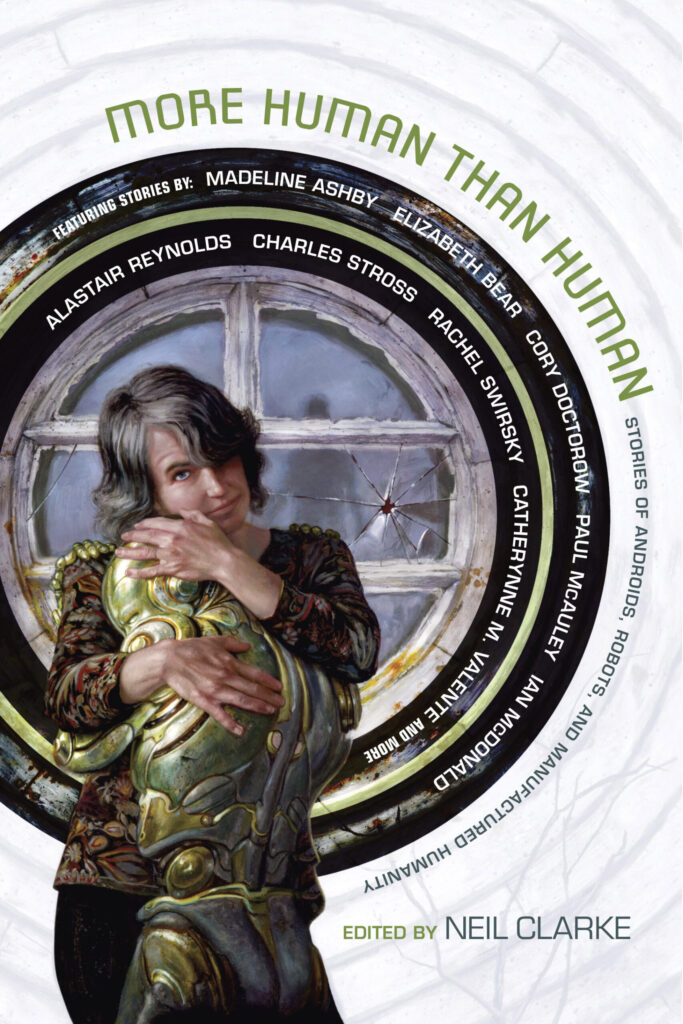MORE HUMAN THAN HUMAN

ed. by Neil Clarke
Night Shade Books
(www.nightshadebooks.com)
2017, 672 pages, $17.99
ISBN 978-1-59780-914-6
Click Here to Purchase
Here are the best stories from the anthology, MORE HUMAN THAN HUMAN:
“Dolly” by Elizabeth Bear. A crime-scene investigation into a companion-like robot, or “doll,” involves an AI doll discovered with blood on her, while her human companion lies dead, presumably murdered by the doll. What has become of the doll, now that she has fallen in love with music, contrary to its (her?) program? Can the doll confess to a murder, let alone commit one?
“Brisk Money” by Adam Christopher. The world in 1962 is sufficiently advanced that robots have assumed some jobs, even as private investigators. One PI is Ray, a robot detective, who finds himself assigned-programmed to a very peculiar case by his (its?) AI manger, the seductive and all-too-clever Ada. Ray is assigned to pick up a parcel of money from an unidentified target. Why? Meanwhile, Ray seeks answers to gaps in his/its program. To do so, he travels to the laboratory where he was created to visit his inventor, Professor Thornton. Perhaps Thornton has the answers, or can fix Ray’s programming, or can find out exactly what that rogue AI, Ada, knows. But what does the all-knowing Ada have in store for Ray?
“Act of Faith” by Fadzlisha Johanabas. Advanced household android RX-718 is programmed with a name, Sallehuddin, and begins to give good care to Daud, father of Jamil. Jamil believes his father treats the robot as another son, and the android is learning to be human. Can Sallehuddin have a soul? Can a robot be Muslim?
“The Caretaker” by Ken Liu. “Sandy,” perhaps an acronym for Sunshine Autonomous Nursing Device, or maybe just an assisted-living robot, remains just a glorified, AI-gifted wheelchair, programmed to care for Mr. Church. But there is, to Church, something odd and a bit “off” about Sandy. While Sandy can demonstrate enough skills to be a home-care aid, it can’t explain many of its unusual actions. Is there something about the human connection that Sandy won’t reveal?
“The Man” by Paul McAuley. A naked man, who happens to be a robot, visits Cho Ziyi late at night, wandering as if lost. Ziyi discovers later on that the robot is a replicant of a man named Tony Daniels, and some are after Daniels because of his value as a machine. But Ziyi insists the robot is a man and vows to protect him.
“Small Medicine” by Genevieve Valentine. Like Ray Bradbury’s short story, “I Sing the Body Electric,” the family in “Small Medicine” is so in love with the robot Grandmother that they bring her personality to the Mori (Memento Mori). But even the best automatons fall short of the real thing.
“I, Robot” by Cory Doctorow. The novel, Isaac Asimov’s CAVES OF STEEL meets George Orwell’s 1984 in a future that casts robots as inevitable and omnipresent, either as cops or criminals. Human cop Arturo Icazade Arana-Goldberg seeks his daughter, Ada, who has been either abducted or killed. Does the ever-present, tyrannical Social Harmony have anything to do with her disappearance, and are these agents committing a crime in dealing with contraband positronics? How are they involved in Ada’s disappearance?
“Today I am Paul” by Martin L. Shoemaker. Paul or, more accurately, Medical Care Android BRKCX-01932-217JH-98662, is a mechanical caregiver for Mrs. Mildred Owens, a dementia patient, and sometimes she can remember Paul, despite her ever-present forgetfulness. That is OK to Paul, as the unit exhibits empathy and can alter its personality to suit the care. For any number of personalities, it can adjust accordingly.

